Quantum Physicist and 2018 Australian of the Year, Professor Michelle Simmons explains her field of study and reflects on her portrait by Selina Ou.
This video was produced with funds donated by Tim Fairfax AC.
Michelle - I remember leaving one day and there was this 10-year-old with his mum. They had walked somewhere and they needed a rest, and she was just walking back, and he was looking through the window of the labs and she was trying to explain what it was but she had no idea. So, I said, "I'll tell you what it is a scanning something." And he said, "Oh is this where the quantum computer "is being built?" And I said, there's this ten year old - he'd heard of it. I said, "Yeah yeah do you want to see it?" And he's like, "Oh Yeah!" So I took him in, and I showed him one of the chips being measured and you could see everything. I was always a very curious child. I looked around the world, and I used to think, gosh, how does that plane get off the ground. I had a bicycle and I remember fixing my bike, and then trying to figure out how every part of it worked. And so as I grew older, and older, I suddenly realised that I liked things that were difficult. And understanding how things work was very interesting. At the age of 13, I realised I love physics. I'd started doing it at school, I could see that you could describe the world with words, descriptively, but you could also do it mathematically. And that's what physics was, it was kind of the combination of both and I just thought that was fantastic. I'd finished doing my Ph.D. and I did some research at the Cavendish in Cambridge, and I realised there that I loved quantum physics, so the more I involved the harder the subject that I took on and at Cambridge it was very fundamental quantum physics, which I loved, but then I really wanted to build something. I wanted to do something that would be useful. And at that time there was a researcher in Australia who was actually from the labs in the U.S. and he was here for three years on a research fellowship, and he wrote a paper that said if you could control the world at the level of atoms, you could build a new type of computer that would be much more powerful. And the research I was doing in Cambridge was very similar to that, and I suddenly thought hey, I've got the skill set that could actually help realise that project. The research that we're doing is really designing new hardware, a new computer chip for the future, and really honestly when we first said that this theoretical paper came out and it said if we could do this, this is the kind of speed-up you would get. And I remember thinking that science is right on the edge of what's possible now, as of that day which was back in 1999. And then we literary wrote out an eight point plan. How do we do it? Eight different stages and when we published that plan people said it looks great, but none of those stages have been realised and the chances of doing all eight is pretty impossible. But really the first couple of stages was bringing two technologies together that haven't worked, and that is the ability to manipulate atoms, which requires a certain kind of tool, with it the ability to encapsulate them, without them moving away from where you've put them. So that's another tool, and that was really the concept at the time, can we bring those two tools together, and make a device taking it through both tools and then bring it out again? I remember that point of signing off for the tool, knowing that if it didn't work this is probably the end of my career. We had a prediction of what we were expecting to see once the tool was operating and it actually turned out to be a factor of six better than we predicted, and so I remember when I saw the result for the first time thinking yes! Nothing beats that really and I've had that many times in my life, that something, yes! It was just fabulous and running around and showing everybody the image of what it looked like and you know everyone going, "Oh Wow!" 'Cause we weren't expecting it to be that good. One of the great things about the kind of techniques that we've developed is it's very open ended, so we are, at one level trying to build the hardware for a new type of computer and that is a very focused programme. But I'm conscious that we're developing technology that could be used for many other things, and certainly my goal is really just to see if we can understand the world at the level of atoms. So my hope is that, that fundamentally is the biggest benefit for what we do, 'cause we will design new tools, and we'll have new models to understand the world at that level and that will help us to understand how things form, eventually, hopefully, it will help us to understand how the human body forms, and how the brain works. That's the long term goal that I'd love to see. I realise there's a huge possibility out there and I just really just want to push it as far as we can to see what it can do. Working with Selina it was absolutely fantastic, for me getting to work with a professional at the top of their game, because I'm a physicist I have understanding of importance of a light and the setting, so I was fascinated to see what she did. It's very relaxed, very calm, thoroughly enjoyed the day. It was absolutely fantastic, and I've seen the portrait it's absolutely fabulous.
Selina - Yes, well I was very excited, and slightly nervous. But when I heard it was Professor Michelle Simmons, I was all on board, I was super excited to meet this impressive woman, and because I'd been obsessively researching about her, I kind of became a bit of a fan girl, and so I was quite nervous. And it's very true you start looking at all the articles, and watching videos, and formulating ideas and options of how you can photograph them in ways that they haven't been photographed before. In my art practice the environment is just as important as the subject, and so it's about the relationship between the two. So I was quite keen on looking around the University of New South Wales campus. And ultimately that environment was the final location for the actual portrait, and that's what I love about those shoots, is that it's often the option that you hadn't planned for that has that special quality about it, that magic.
Related information
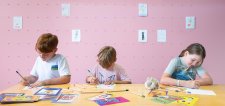
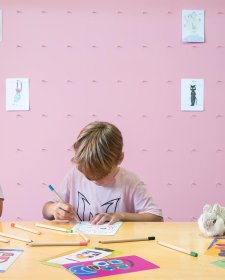

Art cart
Thom Roberts
Drop into the Gallery any time for free creative activities inspired by artist Thom Roberts and his exhibition, The Immersive World of Thom Roberts.
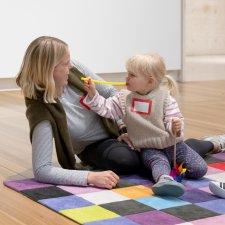
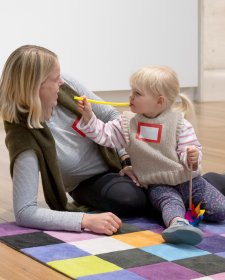
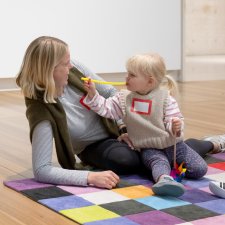
Portrait Play
Face the music
Join us for Portrait Play these school holidays as we explore portraits and music. Come and meet the people that live on our walls, discover musical instruments hidden in the portraits and get creative on your journey through the galleries.
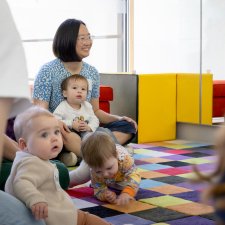
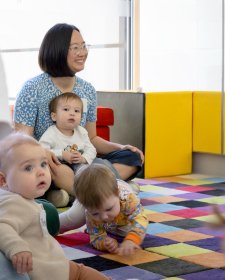
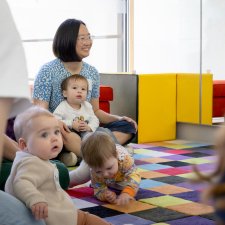
Little Faces
Do we have a treat for the smaller humans in your life! Little Faces is for babies and toddlers (with their grown up) to play, sing and have fun discovering a portrait together.




